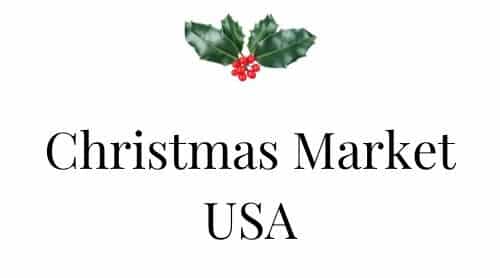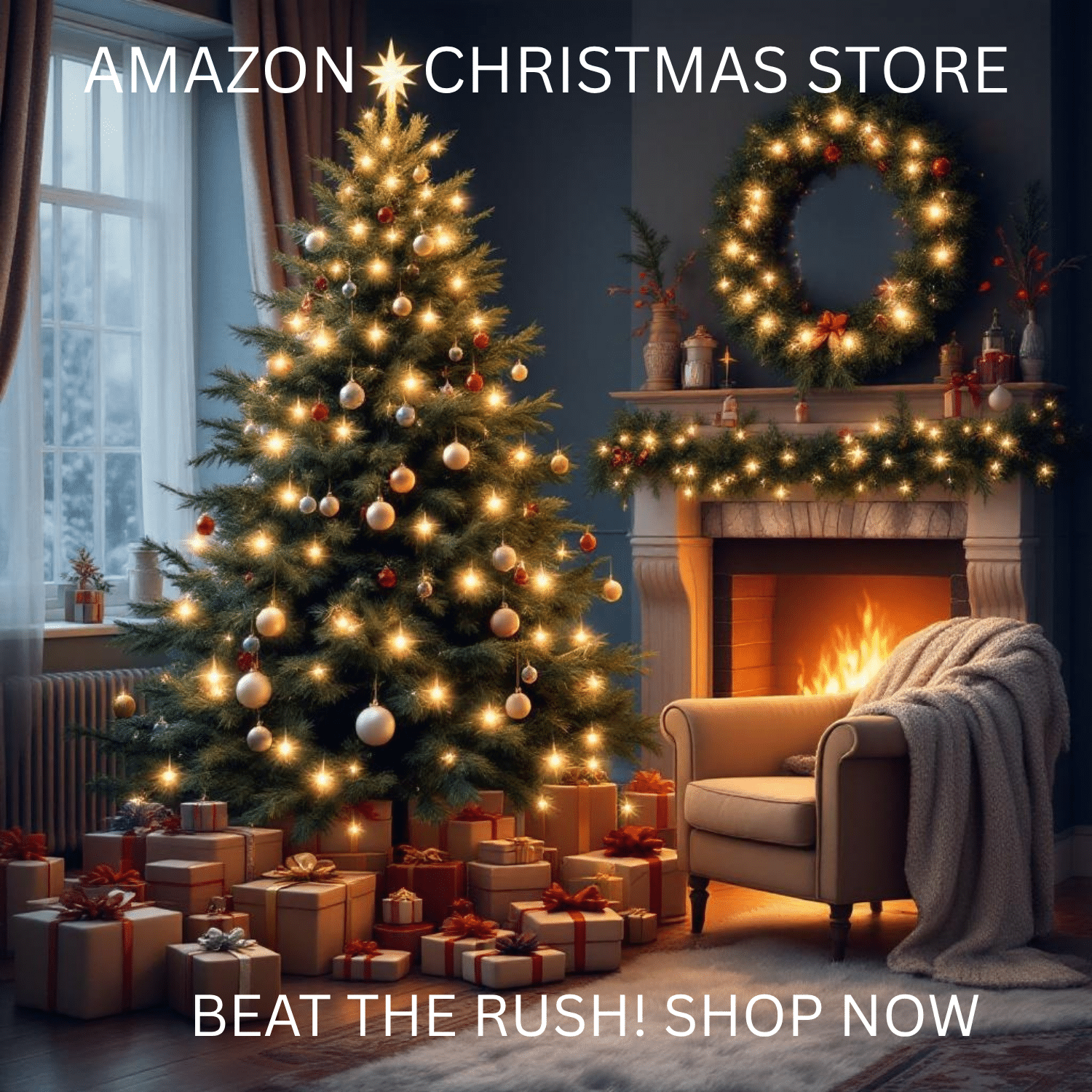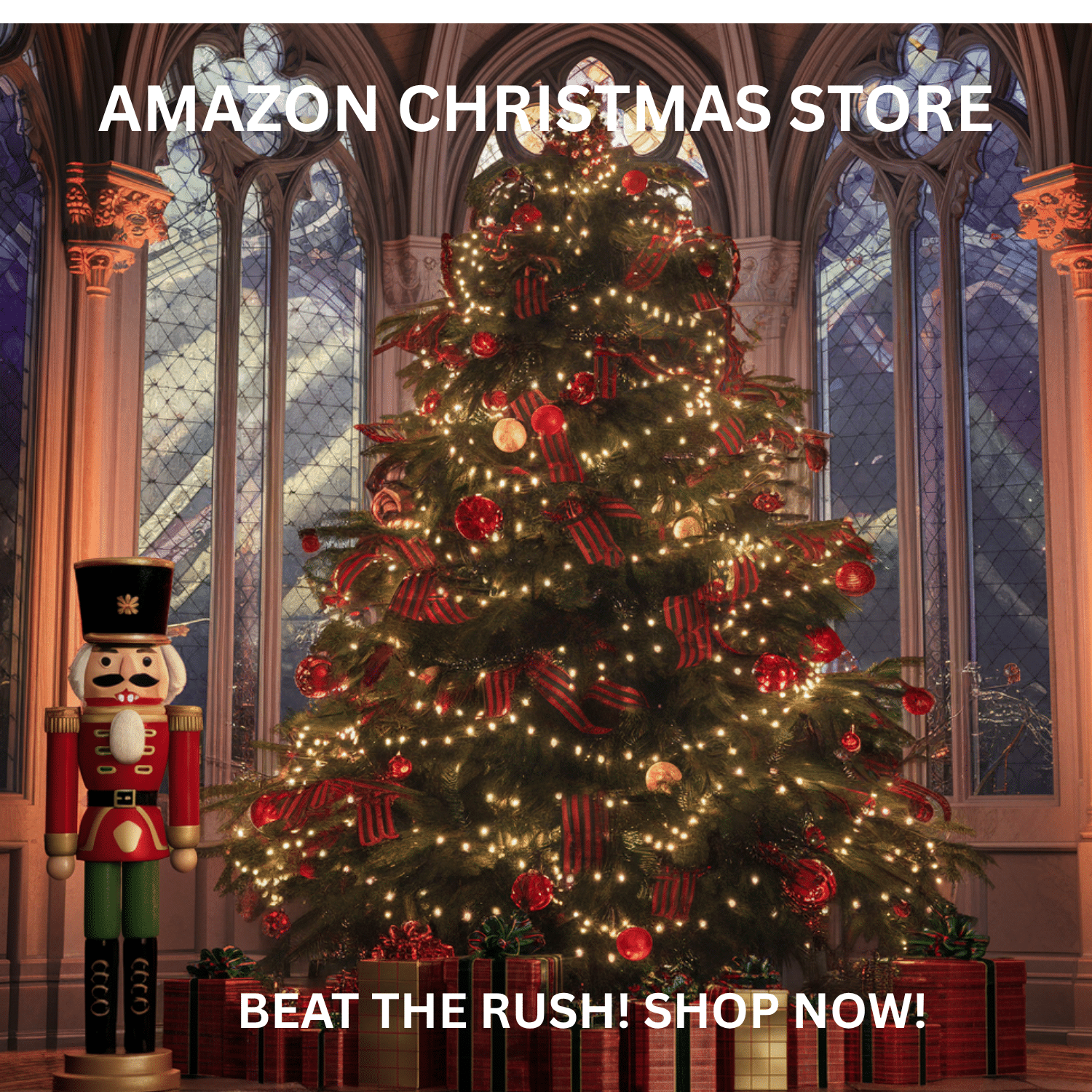Traditions and Customs of American Christmas Markets: A Festive Guide to Holiday Shopping and Cheer
Table of Contents
- 1 Historical Roots of American Christmas Markets
- 2 Distinctive Features of American Christmas Markets
- 3 Cultural Experiences at American Christmas Markets
- 4 Iconic Traditions Across Various Markets
- 5 Regional Variations and Uniqueness
- 6 Why These Traditions Matter
- 7 Planning Your Visit
- 8 Frequently Asked Questions
- 8.1 What are the typical features of a traditional American Christmas market?
- 8.2 How do American Christmas markets compare to European ones?
- 8.3 What are some of the most popular items sold at American Christmas markets?
- 8.4 Can you list the top-rated Christmas markets in the United States for 2024?
- 8.5 What unique American Christmas market traditions exist that contrast with European market customs?
- 8.6 What are the historical origins of American Christmas markets?
Historical Roots of American Christmas Markets

Find the best accommodations and airfares
Check availability at 5* hotels, guest houses and apartments rated "superb" or "exceptional" by visitors just like you.
NO RESERVATION FEES
CHECK AVAILABILITY FOR YOUR DATES HERE
Christmas markets in America have deep European roots. They blend old-world charm with new-world flair, creating a unique holiday tradition. These markets have grown and changed over time, shaped by various cultures and historical events.
Early Influences from European Traditions
Christmas markets started in Europe way back in the Middle Ages. German settlers brought this cozy custom to America. These early markets sold practical stuff like warm clothes and food for winter.
They also had toys and treats for kids. The markets were a big deal in town squares. People came to shop, eat, and hang out with friends.
European touches were everywhere. You’d see German sausages, English puddings, and Dutch Sinterklaas figures. It was like a taste of the old country right in the new world.
The Evolution of Christmas Markets in the USA
As time went on, American Christmas markets got their own style. They kept some European vibes but added new twists. During the Great Depression, these markets became super important.
They gave folks a chance to earn some extra cash. People sold homemade gifts and food. It was a way to spread cheer in tough times.
After World War II, the markets got bigger and fancier. They started popping up in big cities and small towns. Now you could find everything from handmade ornaments to high-tech gadgets.
Influential Figures and Pioneers
Some key people helped make American Christmas markets what they are today. German immigrants led the way, setting up the first markets in places like Pennsylvania and Texas.
Department stores played a big role too. They created magical window displays and Santa’s grottos. This brought the Christmas market vibe indoors.
Local leaders and community groups were important. They organized events and kept traditions alive. These folks made sure the markets stayed true to their roots while growing with the times.
Distinctive Features of American Christmas Markets
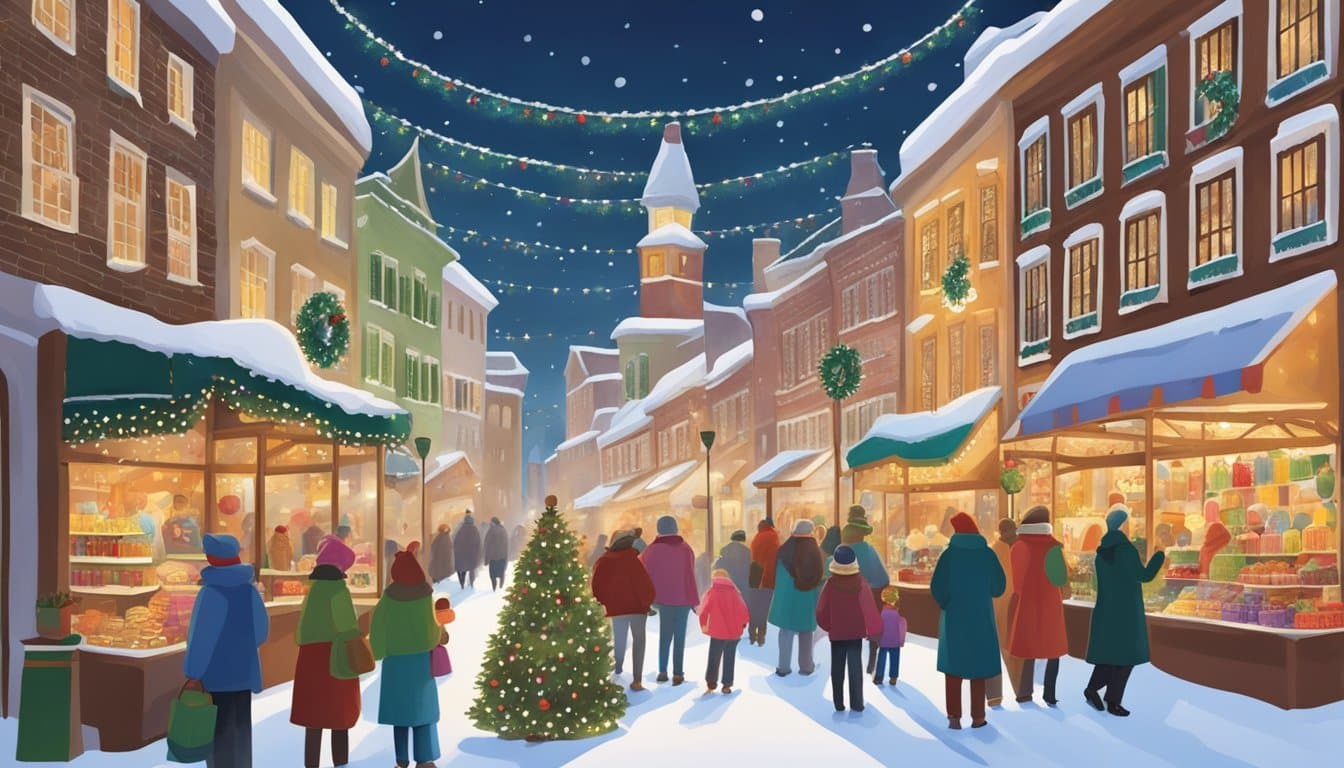
American Christmas markets blend Old World charm with New World flair. They offer a mix of traditional elements and unique local touches that set them apart from their European counterparts.
Unique Food and Beverage Offerings
Food is a big deal at U.S. Christmas markets. You’ll find mulled wine and hot chocolate alongside classic American treats. Eggnog, a creamy holiday favorite, is often spiked with rum for grown-ups.
Gingerbread houses and cookies are must-haves. But don’t be surprised to see twists like gingerbread-flavored everything. Think lattes, cupcakes, and even beer.
Turkey and ham are common for heartier fare. But each market adds its own spin. You might find BBQ in Texas or clam chowder in New England.
Candy canes and peppermint bark are everywhere. Local specialties like saltwater taffy or pralines often make an appearance too.
Handmade Crafts and Artisans
American markets shine when it comes to crafts. Local artisans show off their skills with one-of-a-kind items you won’t find at the mall.
Wooden ornaments are popular. Many feature regional themes like cowboy boots in Texas or lobsters in Maine. Hand-blown glass ornaments add sparkle to any tree.
Knitted goods like scarves and mittens keep shoppers cozy. Quilts and wall hangings often showcase American folk art designs.
Candles and soaps with holiday scents fill the air. Handmade jewelry and leather goods make great gifts.
Festive Decorations and Light Displays
U.S. markets go all out with decorations. Twinkling lights transform ordinary spaces into winter wonderlands.
Giant Christmas trees are the stars of the show. They’re decked out in lights, ornaments, and often topped with a massive star.
Garlands of holly and evergreen boughs drape buildings and booths. Mistletoe hangs in sneaky spots for those hoping for a kiss.
Inflatable Santas and snowmen add a touch of whimsy. Some markets create entire gingerbread villages or ice sculpture displays.
Light shows set to music are becoming more common. They turn buildings into canvases for festive projections.
Cultural Experiences at American Christmas Markets
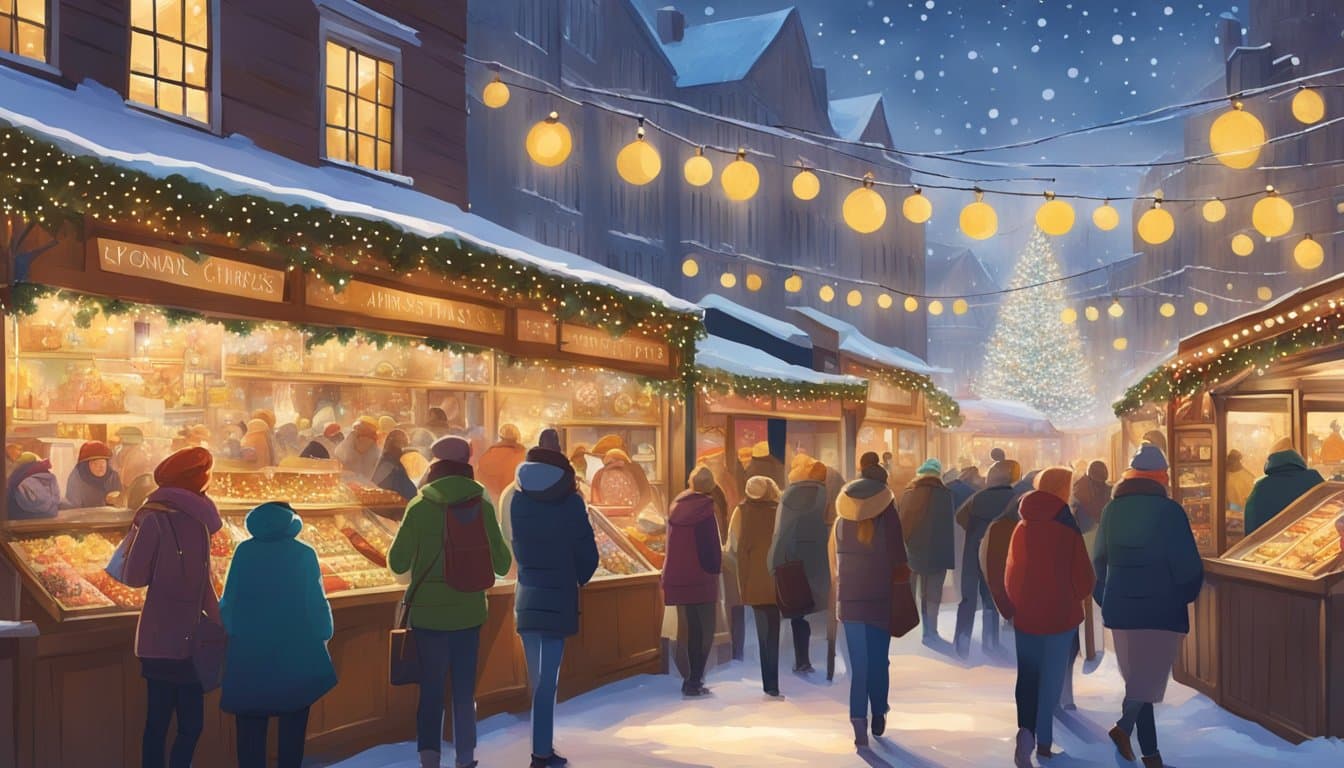
American Christmas markets offer a mix of fun, festive activities that bring communities together. Visitors can enjoy music, food, and crafts that celebrate different cultures and holiday traditions.
Seasonal Entertainment and Performances
Christmas markets come alive with music and shows. Choirs sing carols, filling the air with holiday cheer. Local bands play festive tunes, getting people in the spirit.
Some markets have live nativity scenes or puppet shows. These tell the Christmas story in a fun way for kids. Street performers dressed as elves or Santa add to the magic.
At night, light shows dazzle crowds. Colorful displays set to music create a winter wonderland feel. In some places, ice skating rinks let visitors glide under twinkling lights.
Interactive Activities for Families and Children
Kids love the hands-on fun at Christmas markets. Many have craft stations where children can make ornaments or decorate cookies.
Santa’s Workshop is a popular spot. Kids can meet Santa, share their wish lists, and take photos. Some markets have reindeer petting zoos or sleigh rides.
Carmel Christkindlmarkt in Indiana offers German-inspired activities. Families can learn about European holiday customs while having fun.
Games and contests keep everyone entertained. Gingerbread house competitions and ugly sweater contests are common. These bring laughs and create lasting memories.
Local Communities and Cultural Representations
Christmas markets showcase local talent and traditions. Artisans sell handmade goods, from jewelry to wooden toys. Food vendors offer regional treats and holiday classics.
Many markets highlight different cultures. The Tomball German Christmas Market in Texas celebrates German heritage. Visitors can enjoy German food, music, and dancing.
Some markets feature multicultural displays. These show how different groups celebrate the season. It’s a chance to learn about Hanukkah, Kwanzaa, and other winter holidays.
Local schools and community groups often perform. This brings neighbors together and supports young talent. It’s a great way for markets to connect with their cities.
Iconic Traditions Across Various Markets
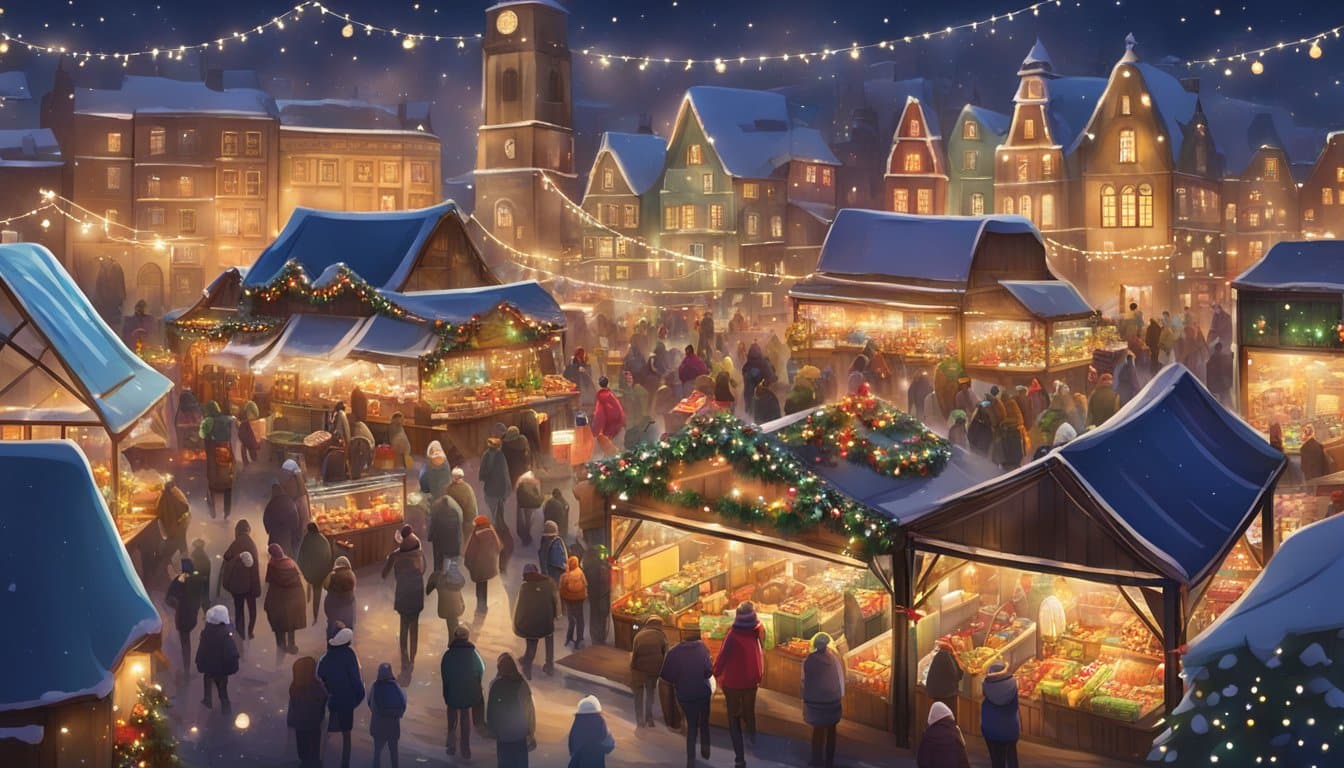
Christmas markets in America bring joy through festive customs. They feature dazzling lights, visits from Santa, and merry parades that capture the holiday spirit.
Tree Lighting Ceremonies
Tree lighting events kick off the holiday season at many markets. Crowds gather to watch massive evergreens come alive with twinkling lights. Some markets go all out with towering trees over 50 feet tall.
The ceremonies often include:
• Countdown led by local celebrities
• Carolers singing classic tunes
• Hot cocoa and cookies for spectators
Kids love pushing the big button to light up the tree. It’s a magical moment that brings smiles to all ages. Some markets add extra flair with fireworks or snow machines for a wintry touch.
Santa Claus Visits and Photo Opportunities
No Christmas market is complete without jolly old St. Nick. Santa sets up shop in cozy cottages or ornate thrones. Kids line up to share their wish lists and snap a festive photo.
Many markets offer:
• Free visits with Santa
• Professional photographers for purchase
• Elf helpers to manage the queue
Some spots add a twist, like Santas in traditional German outfits. Others bring in live reindeer for an extra dose of North Pole magic. It’s not just for kids – plenty of adults get in on the Santa photo fun too.
Traditional Holiday Parades
Parades bring Christmas cheer to the streets around markets. Colorful floats, marching bands, and costumed characters delight crowds. Many parades have themes tied to local history or culture.
Popular parade features include:
• Santa’s sleigh as the grand finale
• Toy soldiers and dancing elves
• Local school and community groups
Some markets go big with nighttime light parades. Floats decked out in thousands of bulbs create a dazzling spectacle. Onlookers bundle up with hot drinks and snacks to enjoy the show. It’s a festive way to bring the community together and spread holiday cheer.
Regional Variations and Uniqueness

Christmas markets across America show off local flavors and customs. From big cities to small towns, each market has its own special twist on holiday cheer.
Differences Between Urban and Rural Markets
Urban markets often go big and flashy. New York City’s markets light up the streets with dazzling displays.
Rural markets keep things cozy and down-home.
City markets have more vendors and bigger crowds. They stay open later too.
Rural markets are smaller but feel more personal. You might chat with the artist who made your ornament.
Some city markets charge to get in. Rural ones are usually free.
Big city markets have fancier food like gourmet hot chocolate. Country markets serve up simpler treats like cookies and cider.
Influence of Local Cultures and Customs
Local culture shapes each market’s vibe. New Orleans markets have a Cajun flair. You’ll find gumbo and seafood alongside the usual holiday fare.
German roots show up strong in some spots. The Carmel Christkindlmarkt in Indiana feels like a slice of Bavaria. They’ve got a big wooden Glühwein Pyramid all lit up.
Some markets mix in other winter holidays too. You might see Hanukkah or Kwanzaa stuff for sale. It’s America’s melting pot in festive form.
Notable Examples of Unique Regional Markets
Chandler, Arizona wins the prize for oddest tree. They build the world’s biggest tumbleweed Christmas tree each year. It’s a spiky desert twist on tradition.
Chicago’s Christkindlmarket is a German-style extravaganza. They serve hot spiced wine in cute boot-shaped mugs. Kids love the giant pretzels.
Leavenworth, Washington turns into a Bavarian village all year. But at Christmas, it goes all out. The whole town twinkles with a million lights.
San Antonio’s River Walk transforms into a floating market. Boats decked in lights carry carolers down the river. It’s like Venice with a Tex-Mex twist.
Why These Traditions Matter

American Christmas markets blend old-world charm with modern holiday cheer. These festive gatherings bring people together to celebrate the season while supporting their communities.
Enhancing the Holiday Spirit
Christmas markets add sparkle to the winter season. Twinkling lights and cheerful decorations transform ordinary spaces into magical wonderlands. The scent of cinnamon and pine fills the air, instantly putting visitors in a festive mood.
Carolers sing familiar tunes, reminding folks of cherished memories. Hot cocoa and mulled wine warm cold hands and hearts. Kids’ eyes light up at the sight of Santa Claus.
These markets create a joyful atmosphere that’s hard to find elsewhere. They offer a break from the stress of holiday shopping and busy schedules.
For a few hours, people can relax and soak in the season’s magic.
Supporting Local Artisans and Vendors
Christmas markets shine a spotlight on local talent. Craftspeople and artists get a chance to show off their unique creations.
Shoppers can find one-of-a-kind gifts that big stores don’t offer.
Food vendors serve up tasty treats with a local twist. Think gingerbread cookies shaped like state landmarks or hot chocolate with regional flavors.
These markets help small businesses thrive during a crucial sales period.
By buying from local sellers, visitors pump money back into their communities. This economic boost can help towns and cities year-round. Plus, it feels good to know your purchase supports a neighbor’s dream.
Fostering Community and Togetherness
Christmas markets bring people together. Families, friends, and strangers mingle as they browse the stalls. The shared experience of enjoying festive sights and sounds creates a sense of belonging.
Many markets feature activities that encourage interaction. Ice skating rinks, cookie decorating stations, and group caroling sessions get folks talking and laughing.
These moments build connections that can last beyond the holiday season.
For some, attending the market becomes a cherished yearly tradition. It’s a chance to catch up with old friends and make new ones. In our fast-paced world, these gatherings remind us of the importance of slowing down and connecting with others.
Planning Your Visit
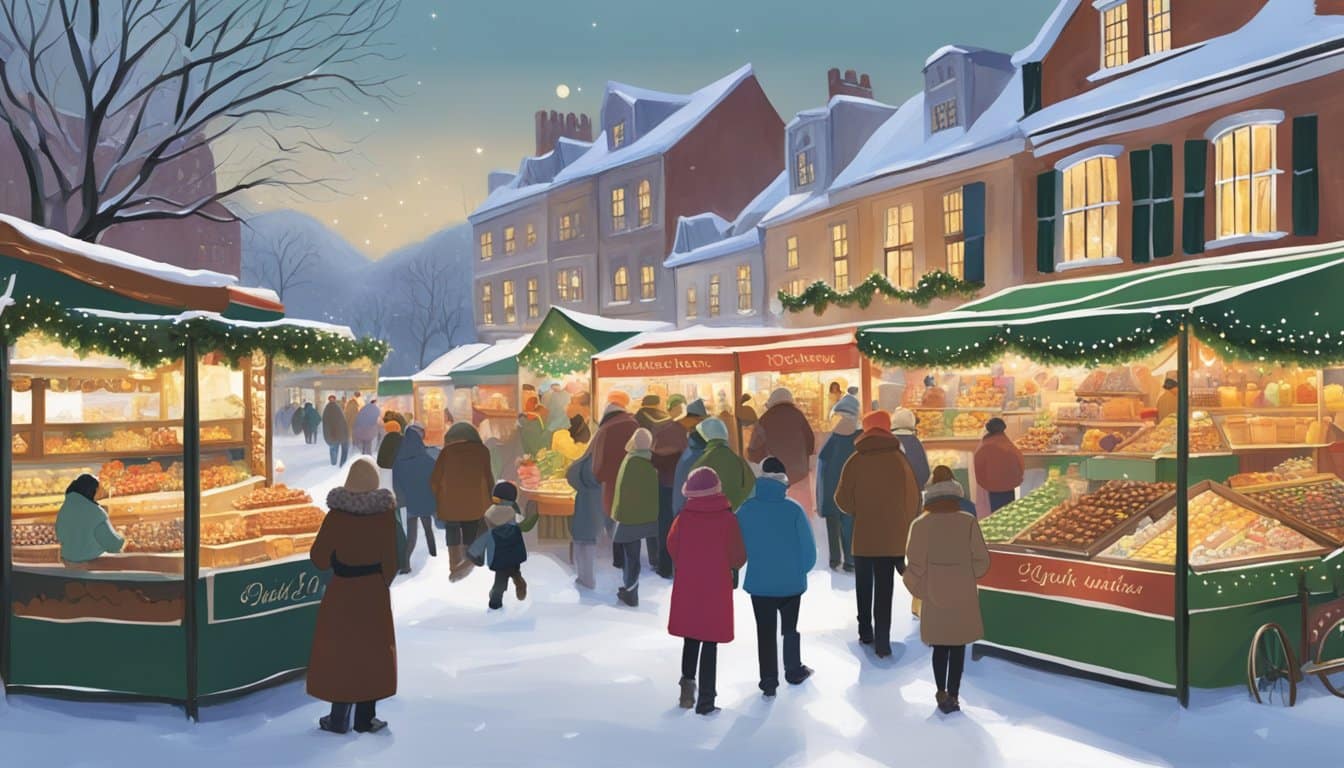
Christmas markets in the US offer festive cheer and unique shopping experiences. Knowing when to go, what to expect, and which markets to check out can make your visit extra special.
Best Times to Visit Various Markets
Most US Christmas markets open in late November and run through December. Weekends tend to be busiest, with peak crowds in the evenings.
For a calmer experience, try visiting on weekdays or during daytime hours.
Some markets have special events on certain days. The Chicago Christkindlmarkt often hosts parades and performances on weekends. Check market websites for event calendars.
Weather can affect outdoor markets. In colder regions, bundle up and consider visiting earlier in the season before the real chill sets in. Southern markets may be more comfortable later in December.
Tips for a Memorable Experience
Bring cash. While many vendors take cards, some are cash-only. ATM lines can get long.
Wear comfy shoes. You’ll likely do lots of walking.
Try the food! Most markets have yummy treats like:
- Roasted nuts
- Gingerbread
- Mulled wine
- Sausages
Buy a festive mug. Many markets sell special mugs for hot drinks. They make great souvenirs.
Take pics, but be quick. Popular photo spots can get crowded.
Chat with vendors. They often have cool stories about their crafts.
Recommended Markets to Explore
Bethlehem, Pennsylvania’s Christkindlmarkt is a top pick. It has over 150 vendors in a charming historic setting.
Chicago’s Christkindlmarket brings German traditions to the Midwest. It’s known for great food and drink.
For a twist, try Charlotte Christmas Village in North Carolina. It’s newer but growing fast.
Pittsburgh’s Holiday Market offers a cozy vibe in Market Square. Alpine-style chalets add to the charm.
Frequently Asked Questions

American Christmas markets blend traditional European elements with unique local flair. They offer festive shopping experiences and holiday cheer in towns and cities across the country.
What are the typical features of a traditional American Christmas market?
American Christmas markets often have twinkling lights and cozy wooden stalls. You’ll find hot cocoa, mulled wine, and tasty treats like roasted chestnuts.
Many markets feature live music and carolers. Kids can visit Santa or ride on carousels. Craft vendors sell handmade gifts and ornaments.
How do American Christmas markets compare to European ones?
American markets tend to be smaller and newer than their European counterparts. They often mix in local touches like food trucks or regional specialties.
European markets usually have deeper roots in tradition. But American ones make up for it with creativity and flair. You might see ice skating rinks or holiday-themed escape rooms.
What are some of the most popular items sold at American Christmas markets?
Shoppers love picking up unique ornaments and decorations. Handcrafted jewelry and accessories are big hits too.
Food is a major draw. Artisan chocolates, jams, and baked goods fly off the shelves. Many folks stock up on specialty hot sauces or local honey.
Can you list the top-rated Christmas markets in the United States for 2024?
The Christkindlmarket in Chicago is a perennial favorite. New York’s Union Square Holiday Market dazzles city-dwellers.
Denver’s Christkindl Market brings Alpine charm to the Rockies. The Texas Christkindl Market in Arlington adds Lone Star spirit to German traditions.
What unique American Christmas market traditions exist that contrast with European market customs?
Some American markets embrace local history. The Great Dickens Christmas Fair near San Francisco recreates Victorian London.
You might spot food trucks serving up fusion tacos next to traditional bratwurst stands. Many U.S. markets feature charity drives or “giving trees” for local causes.
What are the historical origins of American Christmas markets?
American Christmas markets are relatively new. They started popping up in the late 20th century.
Many were inspired by German-American communities sharing their traditions. The markets grew as Americans sought more festive, community-centered holiday experiences.
Christmas Market Closures
Due to econonic conditions and tariffs, some Christmas Markets may cancel their events due to lack of vendors. If you are aware of a closed market,or find errors on a listing or an image, please reach out on our Contact Us page so that we may update this post.
